Quick Summary
TL;DR: B2B SaaS content development helps startups attract their target audience, educate buyers, and shorten sales cycles. With lengthy decision-making processes and multiple stakeholders involved, clear content explaining the product is essential to build trust and support every stage of the buyer’s journey. #tldr
- Main Takeaway:
Strong content development is a vital growth driver for B2B SaaS startups. When strategy, SEO, and distribution align, content boosts visibility, conversions, and reduces churn. Regular publishing and performance tracking help startups grow faster and build credibility in their industry.
- Content Development Strategies:
Thought Leadership and Building Authority → Product-Led Content Development → Multi-Format Repurposing Framework → SEO-Driven Content Development
- Key Insights:
SaaS buyers consume more than half of the content before speaking to sales, so your content must guide them from awareness to decision.
- Final Takeaway:
Advanced content development creates educational material that guides buyers and showcases product value, benefiting marketing, sales, and retention for SaaS startups.
For growing software companies, B2B SaaS content development plays a critical role in driving awareness, nurturing leads, and closing deals. It serves as the foundation for building trust with potential buyers, guiding them through complex decision-making processes and positioning your software as the clear solution. From product explainers to in-depth case studies, the right content helps SaaS companies shorten sales cycles and create lasting customer relationships.
According to a 2024 Content Marketing Institute report, 71% of B2B marketers say content marketing has become more important to their organization over the last year. This highlights the importance of consistent, high-quality content for SaaS brands aiming to differentiate themselves in crowded markets and convert attention into tangible business growth.
Why Content Development is Mission-Critical for B2B SaaS
Unlike physical products, SaaS solutions are intangible. Buyers can’t pick them up, test them in a store, or experience them in person. Instead, content becomes the closest thing to a product experience. A well-structured demo video, a detailed case study, or a practical how-to guide helps potential customers understand not only what your software does but also why it matters to them.
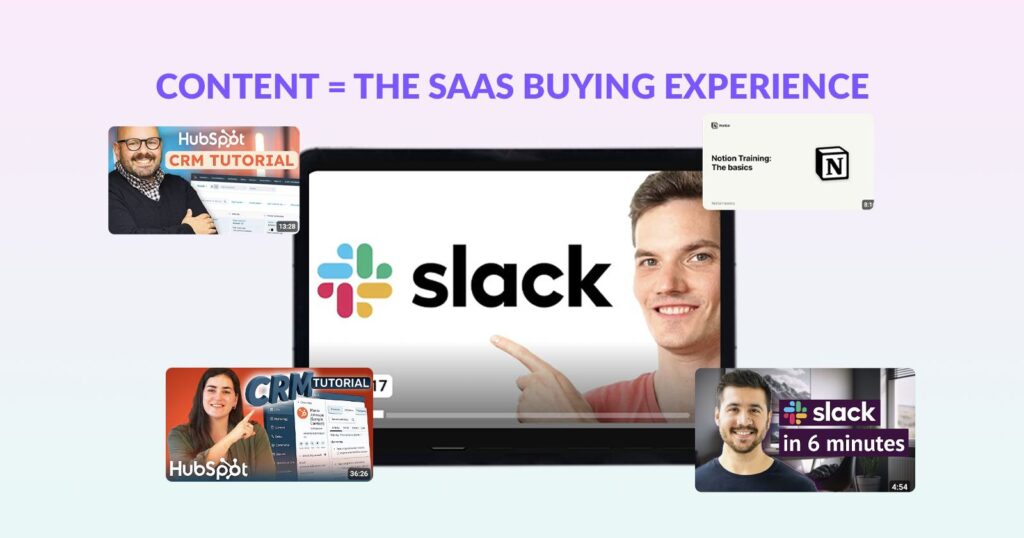
B2B SaaS sales cycles are usually long and involve multiple decision-makers, each with unique concerns. Content is the bridge that nurtures these stakeholders, from the executive who needs ROI clarity to the end-user focused on usability. In fact, Demand Gen Report shows that B2B buyers typically consume 51% of content before ever talking to a sales rep. ShortVids demonstrates how SaaS companies leverage Facebook Ads with compelling content to attract thousands of qualified leads. This example highlights how content helps build awareness and attract customers in competitive markets.
The Foundations of B2B SaaS Content Development
Creating content for SaaS involves more than just writing articles or making videos. First, you need to know why you are creating the content. Next, identify who your target audience is. Finally, understand how your content helps customers during their buying journey. Without this clarity, even high-quality content can miss the mark because it fails to connect with business objectives or customer needs.
Defining Your Content Goals (Beyond Awareness)
Too often, startups limit content to brand awareness, but real growth comes from setting broader objectives. For SaaS companies, content can play a role in lead generation, activation, customer retention, upselling, and even turning loyal users into advocates. Each goal calls for a different content type, which ensures you’re guiding prospects and customers at every stage.
Here’s a breakdown to illustrate how goals connect with formats.
| Goal | Content Formats (Examples) |
|---|---|
| Awareness | Blogs, LinkedIn posts, infographics |
| Consideration | Webinars, case studies, solution guides |
| Decision | ROI calculators, demo videos, free trials |
| Retention | Onboarding videos, advanced tutorials |
| Advocacy | Customer spotlight blogs, referral program content |
Building Buyer Personas and ICP Alignment
Every SaaS company has more than one type of buyer, and each one evaluates your solution through a different lens. A CFO may want cost savings, while an operations manager may prioritize usability and integrations. To build content that resonates, you need detailed buyer personas aligned with your Ideal Customer Profile (ICP).
One of the most reliable ways to shape personas is by listening to real customer insights. Sales calls, support tickets, and even competitor reviews often reveal pain points and buying triggers you might miss otherwise. When documented correctly, personas help your team write with precision instead of guesswork.
Mapping Content to the SaaS Buyer’s Journey
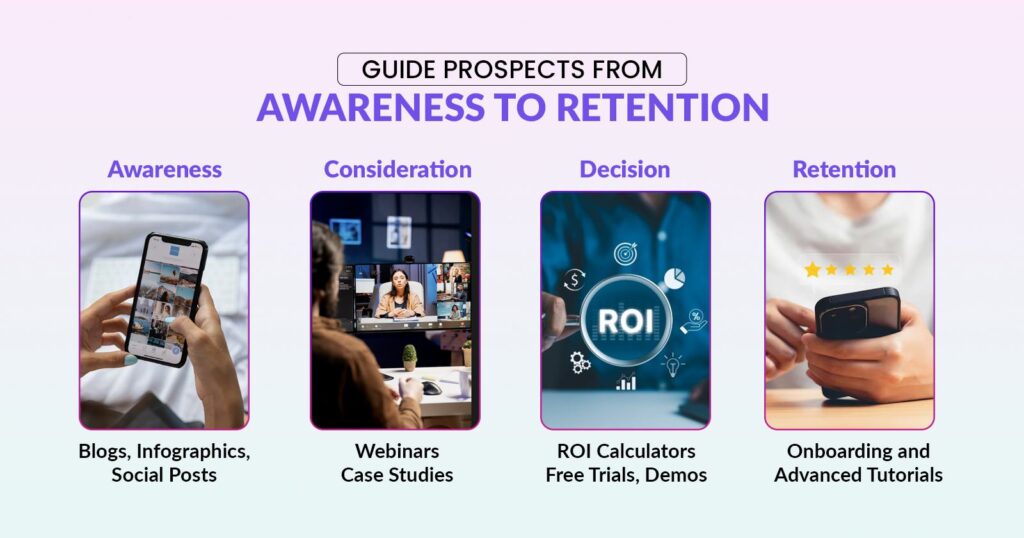
Once you’ve nailed down your goals and personas, the next step is connecting content to the buyer’s journey. Most SaaS buyers don’t go from discovery to purchase overnight. They usually move through
- Awareness
- Consideration
- Decision
- Retention
Consider a straightforward path: a prospect discovers your blog, downloads a helpful eBook, reads a case study that fosters trust, schedules a product demo, and then uses a tutorial to ensure a smooth onboarding process. Each step is supported by content, reducing friction and keeping momentum going.
To strengthen this process, distribution plays a big role. Running B2B business ads alongside your content helps you get in front of the right decision-makers sooner, rather than hoping organic reach alone does the job.
Advanced Content Development Strategies for SaaS Startups
Once the basics are in place, SaaS startups need to think about how to make their content stand out in competitive markets. At this stage, it’s less about publishing more, but rather about publishing smarter. The aim is to create content that builds trust, shows expertise, and guides potential customers to your product in a way that feels easy and helpful.
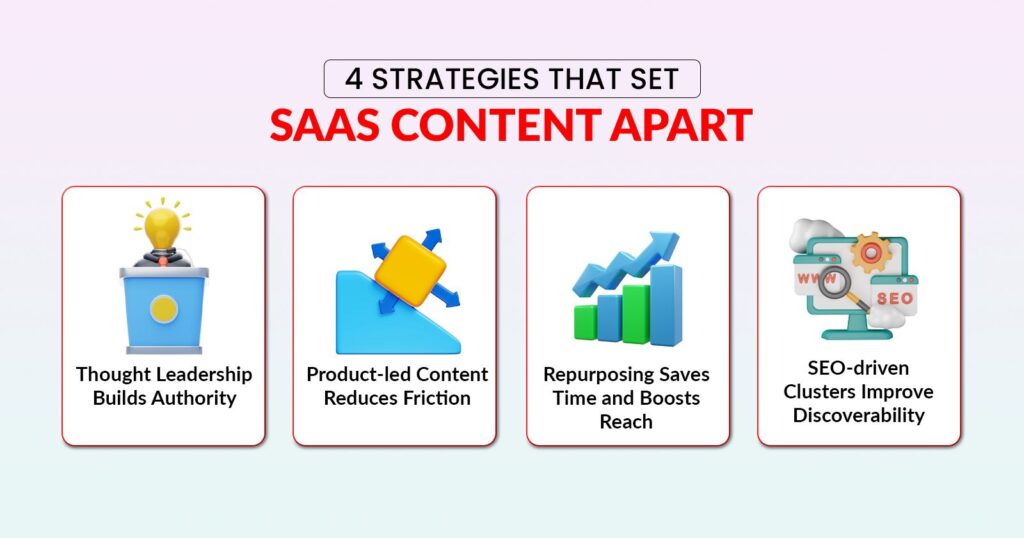
1. Thought Leadership and Building Authority
Establishing your authority is one of the best ways to earn trust in the SaaS world. Rather than just talking about your product, share unique insights that make your brand stand out from the crowd. This might mean publishing a data-led report, running your own research study, or contributing to respected industry blogs. Guest podcast appearances or active LinkedIn publishing can also help position your team as credible voices in the space.
What really matters is credibility. Google rewards expertise and trustworthiness in rankings, and readers respond to content that feels genuine. If you’re building authority through content, understanding Google’s E-E-A-T framework is essential, since it shapes how both algorithms and human audiences evaluate quality.
2. Product-Led Content Development
For SaaS startups, some of the most powerful content is built around the product itself. This doesn’t mean pushing a sales pitch. Instead, focus on showing how the product solves real problems. Use clear language to explain the features, provide a simple step-by-step guide on how to use the tool, or share a customer story that highlights the journey from problem to solution. When done well, this content reduces confusion and makes the product seem like the obvious next choice for potential customers.
3. Multi-Format Repurposing Framework
Not every startup has a big content team, which is why making the most of every piece matters. A single blog post can be repurposed into a short video, an infographic, a LinkedIn carousel, and even an email drip series. This practice, sometimes called content atomization, ensures your best ideas reach people on the platforms they already use, while saving your team from constantly starting from scratch.
For lean SaaS teams, this approach is a lifesaver. It turns one strong piece of content into a month’s worth of material, making consistency easier to maintain.
4. SEO-Driven Content Development
Great content won’t do much if no one can find it. That’s where SEO-driven planning comes in. Instead of focusing on single keywords, SaaS companies should build clusters of related topics around buyer problems and product solutions. A pillar page supported by smaller articles creates both depth and visibility.
It also pays to look at competitor content. Gap analysis reveals unanswered questions and overlooked features by competitors. By filling these gaps, you can improve your rankings and create a more comprehensive content library.
Key Roles in a Content Creation Team (With Responsibilities)
A successful SaaS content development program isn’t the result of one person – it’s the combined effort of a team with clearly defined roles. Each role brings a different strength, from strategy and writing to design and optimization. In some startups, one person might wear multiple hats, but as you scale, these roles become essential for consistency and quality.
| Role | Core Responsibility | Why It Matters |
|---|---|---|
| Content Strategist | Defines content goals, audience, and roadmap | Keeps content aligned with business objectives and SaaS growth |
| Writer/Copywriter | Produces blogs, web copy, and scripts | Builds brand voice and authority across channels |
| Technical Writer | Creates documentation, API guides, and manuals | Reduces friction in product adoption and onboarding |
| Video Editor | Transforms raw footage into polished content | Boosts engagement and communicates complex ideas visually |
| Graphic Designer | Designs visuals, infographics, and branded assets | Improves clarity and makes content more shareable |
| SEO Specialist | Optimizes content for search and keyword visibility | Ensures discoverability and long-term organic growth |
| Social Media Manager | Publishes and promotes content across social channels | Extends reach and engages directly with target audiences |
| Project Manager | Oversees workflow, timelines, and cross-team tasks | Keeps projects on track and prevents bottlenecks |
| AI/Prompt Engineer | Supports content teams with prompt design and automation | Helps teams scale content creation efficiently without losing quality (see more on AI’s role in content creation) |
Clear responsibilities like these prevent overlap, reduce inefficiencies, and ensure each piece of content serves a purpose in the bigger SaaS growth strategy.
Scaling Content Development for SaaS Growth
As a SaaS company grows, content development demand increases across multiple formats – blogs, case studies, video explainers, product documentation, and customer success stories. To keep up, content development needs to move beyond ad-hoc creation and become a structured system. This means building processes that can grow with you, using the right tools, and keeping track of how things are performing. When it’s done right, content becomes a solid way to drive growth instead of just reacting to what’s happening in the market.
Content Operations & Tools
Scaling content requires a well-defined operational framework. A content calendar helps teams know what content they need to create, who is responsible for each task, and when each task is due. Standardized workflows streamline approvals, revisions, and publishing.
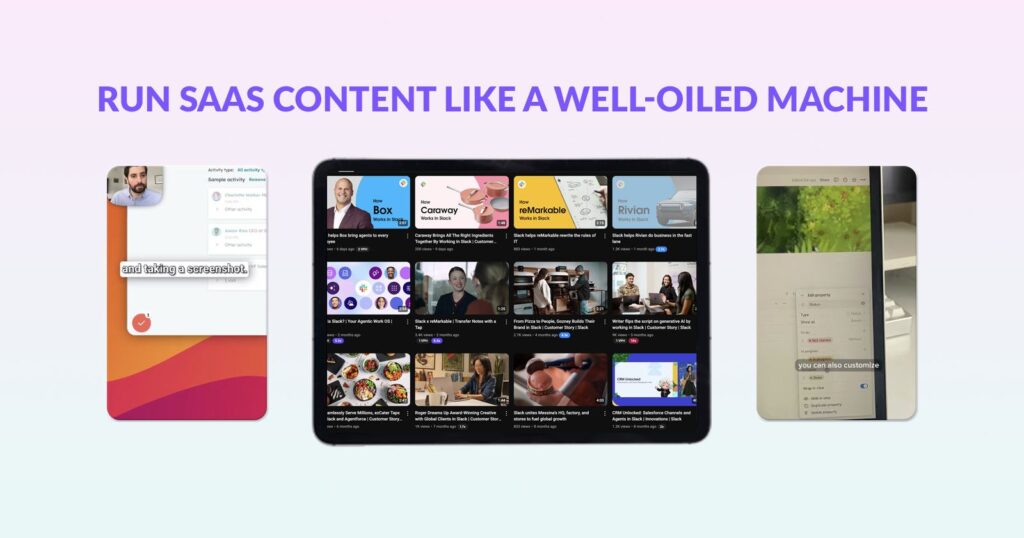
Here are some tools that support scaling content operations. You can also check our list of 30+ Collaborative Tools for Scaling Agency Business.
- Notion – Great for centralizing documentation, content roadmaps, and style guides in one shared workspace.
- Trello or Asana – They are ideal for managing content pipelines with boards, task lists, and progress tracking.
- Ahrefs – It provides in-depth SEO data for keyword research, backlink monitoring, and competitor analysis.
- Clearscope – The tool helps optimize content with semantic recommendations to improve search visibility.
- Loom – Useful for asynchronous collaboration, enabling quick video walkthroughs and feedback across teams.
Modern SaaS teams are also exploring generative AI features in content creation to accelerate production, improve consistency, and automate repetitive tasks.
Measuring & Optimizing Performance
Scaling content without measurement is like flying blind. For SaaS businesses, the value of content is tied directly to pipeline and retention impact. Tracking performance ensures the team is not just producing more content, but the right content.
Key focus areas include:
- KPIs – Monitor marketing-qualified leads (MQLs), sales-qualified leads (SQLs), demo requests, and churn reduction. These metrics tie your content directly to revenue impact.
- Analytics – Platforms like GA4 and HubSpot show traffic sources, attribution, and conversion paths so you can measure what’s actually working.
- Feedback Loops – Input from sales and customer success teams helps confirm whether your content answers real buyer questions and pain points.
By continuously optimizing content based on data, SaaS companies can ensure their content development efforts fuel long-term growth rather than just short-term visibility.
Metrics to Track a Content Creation Team’s Success
The easiest way to know if your content team is doing its job is to look at the numbers. Not vanity numbers, but the ones that show real progress. Consider how much you’re publishing, how people interact with it, whether Google rewards it, and, most importantly, whether it’s converting into leads or sales.
What You Should Keep an Eye On
Content output
How many blogs, videos, or posts are going out each month? And are they going out on time? Consistency is usually more important than volume.
Engagement
Are people actually spending time with your content? Check the average time on page, social shares, comments, or video watch time. These show if your audience finds value in what you’re putting out.
SEO and growth
Organic traffic growth and keyword rankings tell you how well your content is competing in search. Backlinks from credible sites also show that your work is trusted.
Conversions
At the end of the day, you need to know if content is driving sign-ups, demo requests, or sales. Tracking leads and revenue influenced by content makes it easier to prove ROI.
Sample KPI Tracking Table
| Metric Category | KPI | How to Measure |
|---|---|---|
| Output | Blogs or videos published per month | CMS / Publishing tool logs |
| Engagement | Avg. session duration | Google Analytics or GA4 |
| SEO | Keyword rankings | Ahrefs / SEMrush tracking |
| Conversion | Leads from content campaigns | CRM / Marketing automation platforms |
Best Practices for Sustainable SaaS Content Development
Content development for SaaS is a bit like running the product itself – you can’t just launch it and walk away. It needs maintenance, updates, and a plan for how people will find it. Otherwise, you’ll end up with a library of stale posts that no one reads.
1. Keep Evergreen Content Fresh
Your blog post from a year ago may still attract visitors, but is it still accurate? The SaaS industry changes quickly, and so do customer expectations. To keep your old posts relevant, you can update screenshots, add new data, or revise sections to match the current situation. Doing so can help these posts perform as well as new ones.
2. Let Customers Do Some of the Talking
User-generated content is powerful, but often ignored. Reviews, Q&A threads, and casual shoutouts on LinkedIn can show potential customers the real value of your product. The best part is that this content feels more genuine than polished marketing.
3. Don’t Just Create. Distribute.
One of the biggest mistakes SaaS teams make is treating “publish” as the finish line. In reality, that’s the starting point. Content needs to be shared, promoted, and repurposed. A single blog could be broken into LinkedIn posts, turned into an email series, or summarized in a short video. Without this push, even the best content can go unseen. If you’ve faced these struggles, you’ll recognize them from common content creation challenges.
4. Use Tools, but Keep the Human Touch
AI and automation can really help you step up your game. They can outline stuff, transcribe, or even give old content a new spin. But remember, those raw outputs usually need a human touch to adjust the tone, clarify points, and make sure they connect with your audience. If you skip this part, your content might end up feeling flat or generic.
5. Audit Your Library Regularly
Review your posts every 6 to 12 months. Some posts need updates, some should be removed, and a few can be refreshed. This task may not be exciting, but it keeps your content current and helps avoid confusing your readers with outdated information.
Case Studies & Examples of Successful SaaS Content Development
Seeing real examples of how SaaS brands used content development successfully helps you avoid guesswork. These stories don’t just show what worked – they show how brands tied content to real business outcomes. Let’s dig into a few.
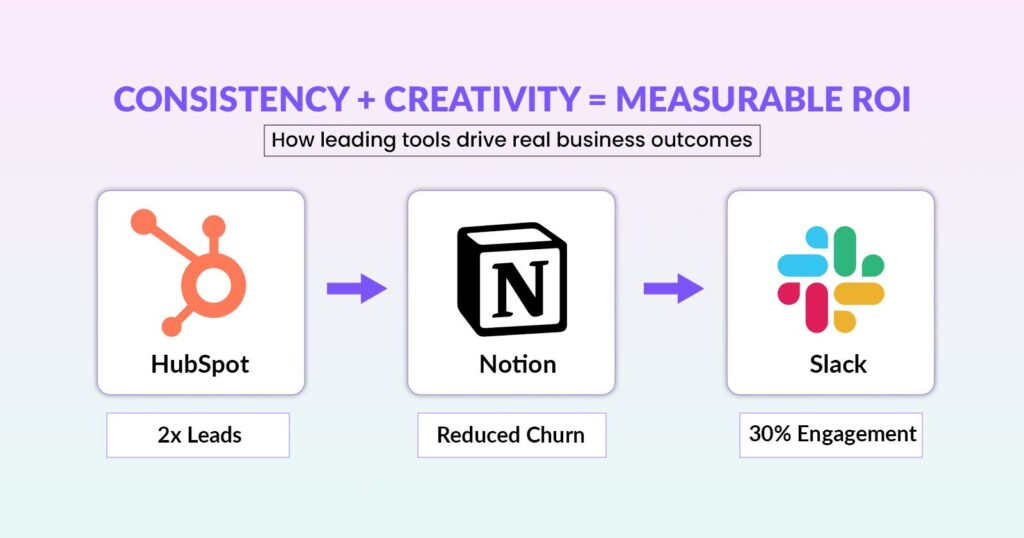
Example 1: Startup Scaling Inbound Leads with SEO + Webinars
HubSpot is one of the best-known examples here. Through a combination of SEO content (blog posts, guides, keyword-targeted pages) plus regular webinars, they’ve built a reliable inbound engine. One HubSpot report shows that customers using their platform often double inbound lead volume when they commit to consistent content + live events.
The lesson: using webinars as part of the content mix not only helps you deliver depth (since you can address complex topics live) but also builds recurring opportunities to engage audiences, capture emails, and push people deeper into the funnel.
Example 2: SaaS Reducing Churn via Onboarding Video Series
Notion is a good illustration here. Their help center and resource library include onboarding tutorials and video walkthroughs embedded directly in the product, making it easier for new users to find answers inside the tool.
In similar SaaS examples (Userpilot, Asana, etc.), companies implementing a structured onboarding series have seen noticeable reductions in support tickets and less early churn. The smoother the start, the more likely users are to stick around.
Example 3: Using Customer Communities for Advocacy
Notion again provides strong evidence here. Their “Customers” page features real workflows and stories from their users (from OpenAI, Figma, Adobe, etc.), showing not just what the product can do, but what real teams are doing with it.
These community stories serve multiple roles: they’re social proof, content fodder, sources of insight into what users care about, and often catalysts for referral or word-of-mouth growth.
These case studies also show a pattern: brands that scale content successfully often pair automation or process improvements with a human touch. As one reads in many of their stories, combining content creation, community, and feedback loops helps avoid burnout and keeps content relevant. If you’re considering tools or workflows to support this, look into content-creation automation solutions for certain repetitive tasks – this can free up creative energy for higher-impact work.
Sample Impact Table from SaaS Content Development Success
| SaaS Brand | Strategy Used | Measurable Impact |
|---|---|---|
| HubSpot | SEO-driven blogs + recurring webinars | 2x inbound lead volume over 12 months |
| Notion | Onboarding video tutorials inside product | 20% reduction in early churn rates |
| Slack | Customer community content + case studies | 30% higher engagement in B2B accounts using community resources |
Final Words on B2B Saas Content Development
Investing early in content development for SaaS startups leads to compounding returns. Advanced content development is the growth engine for B2B SaaS, helping brands win trust, educate buyers, and nurture leads through long decision cycles.
Exploring different formats also ensures you meet your audience where they are. For example, keeping up with video content trends allows SaaS startups to engage prospects in more dynamic and memorable ways.
Frequently Asked Questions
Content development is the process of planning, creating, and optimizing material that serves specific goals such as lead generation or customer retention. Content marketing, on the other hand, is the broader practice of promoting and distributing that content to reach the right audience.
For lean teams, blog posts and educational LinkedIn content are cost-effective starting points. Pairing these with customer success stories or simple product walkthrough videos can build credibility without heavy investment.
Leads often come from gated resources like whitepapers, webinars, or eBooks. A good approach is to attract visitors through SEO-optimized blogs, then capture details with valuable downloadable content that solves a specific problem.
It depends on the stage and resources. Outsourcing is practical for early-stage startups that need quick output without hiring full-time staff. As the company scales, building an in-house team ensures a consistent brand voice and deeper product knowledge.
A few common errors include producing content without clear goals, writing only about features instead of customer problems, ignoring distribution, and failing to measure ROI.
You can track metrics like demo requests, signups, churn reduction, and influenced revenue. Pair analytics tools like GA4 or HubSpot with CRM data to understand how content drives the pipeline.
It’s writing that educates, informs, and persuades B2B decision-makers about a SaaS product. It includes blogs, case studies, landing pages, and product documentation to highlight solutions to customer pain points.
Book a Call Today
- Fixed monthly plans starting at $999
- 24-hour turnaround time (or less) on all short-form edits
- 3-layer quality check system on every video
- No more chasing freelancers or managing editors
- Scale up to 50+ videos/month without hiring in-house
- Content team trained on platform trends, scroll-stopping hooks & storytelling
- Fully managed by professionals – you just upload & approve
- Response time: Under 1 hour (US & GCC time zones)
Cut your production costs, not your standards.


